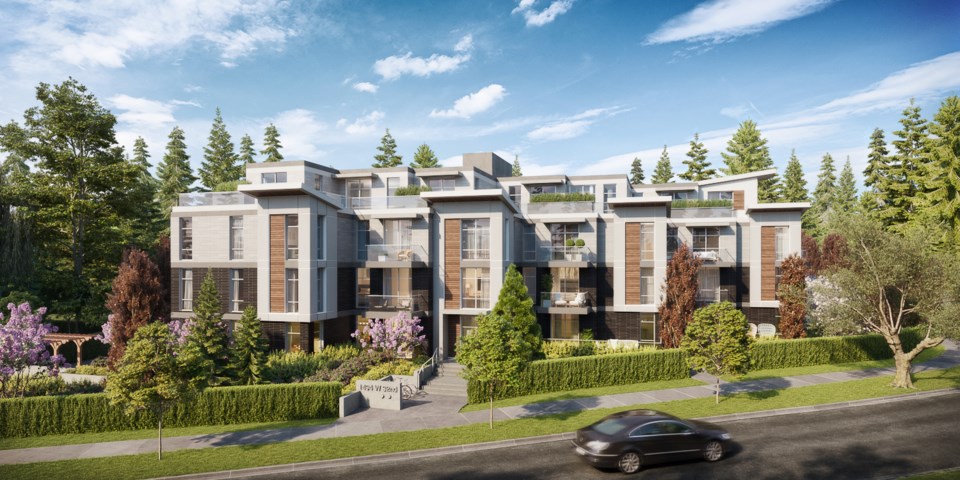A pro-housing activist is troubled by a display board at a March 5 open house indicating the proposed rental building would act as a noise buffer for existing single-family homes in the neighbourhood.
The open house was for Domus Homes’ proposal to construct an 81-unit, four-storey rental building on a site at Granville Street and West 32nd Avenue in Shaughnessy.
The wording Scott de Lange Boom found offensive is on the “Site & Neighbourhood Context” display board under a section about arterial roads. It notes that the Arbutus Ridge/Kerrisdale/Shaughnessy (ARKS) Community Vision encourages multifamily housing along arterials in locations that meet certain criteria, including: “Shield, to some extent, single family homes from the noise of arterial traffic as the new housing types and their landscaping act as a buffer.”
De Lange Boom, a member of Abundant Housing Vancouver who is supportive of the rezoning application, attended the open house and called the context statement “bad” on social media, saying: “City policy explicitly views renters as a human shield for single family home owners.”
The context statement is bad. City policy explicitly views renters as a human shield for single family home owners pic.twitter.com/JAV5rlPYeG
— Scott de Lange Boom (@Scott_dLB) March 6, 2020
He told the Courier Friday he didn’t want the issues he has around phrasing “to take away from the fact that I really do support rental properties to be built in Shaughnessy and across the city,” but he objects to the “shield” reference and the fact rental and condo buildings have mostly been limited to arterials.
(Regulation changes are currently in the works to help implement new city policy in areas not already covered by community plans or where community plans are underway. It would allow consideration of rezoning applications for rental buildings in specified transition zones 150 metres off some arterials, and within walking distance — 400 metres — from schools, shopping, parks and transit. There has been mixed reaction to the plans, with pro-housing activists such as de Lange Boom arguing the plans are not aggressive enough. Read more HERE).
“[I’m] concerned that the least affordable type of housing — single-family detached and duplex — is all that is legally allowed to be built in approximately 75 per cent of the city, which is a major contributor to the housing affordability crisis,” de Lange Boom said.
While the display boards were produced by the applicant, de Lange Boom blames the City of Vancouver for what he considers anti-renter and anti-condo owner policies.
“The developer was not tactful in how they phrased their open house material. However they [are] merely describing what is the city's implicit policy, and therefore the majority of the responsibility lies with the city,” de Lange Boom said.
He noted that on page 40 of ARKS’ community vision, approved by council in 2005 under then mayor Larry Campbell, uses almost the same language. It states that “vision participants identified arterials as a location for other housing types to be located on or near.”
“This location would,” among other things, “shield, to some extent, adjacent single family homes from the noise of arterial traffic as the new housing types (with good construction practices like double-glazed windows) and their landscaping act as a buffer.”
De Lange Boom also pointed out Domus Homes' rezoning application was submitted under the city’s Affordable Housing Interim Choices Rezoning Policy, which wouldn’t have allowed the project off an arterial road.
He said he's tired of renters and condo owners being treated as second-class citizens.
“Under city policy, new developments get concentrated on arterial roads where [it is] noisier [and] there's more car pollution from both exhaust and brake dust that has negative health impacts for people who can't afford to buy a single-family home. It's bad for people's health, for the environment and on equity grounds as well,” he said.
“I think the city's figured it’s politically easier to throw renters under the bus on this one rather than deal with neighbours who dislike new housing in their neighbourhoods.”
He added that policies limiting where rental and condo buildings are constructed also put pressure on small businesses on arterials, which have to take the brunt of redevelopment. Aside from being at risk of being knocked down to make way for new buildings, they also have to cover property taxes for the highest and best use of a site.
De Lange Boom would like city policies to encourage what’s been created in the West End, where low-rise commercial buildings are on the main roads that front major streets such as Robson Street and most of the housing is set back from the main roads.
“That allows it to be a lot quieter, takes the pressure off of the businesses there. It creates a much better neighbourhood that has better quality of life when all of the renters, all the new condo owners, aren’t pushed on to the noisy polluted roads.”
Until three months ago, de Lange Boom was living on an arterial road — in an apartment on East Eighth, facing Broadway.
He said traffic noise was a problem, particularly in summer months when motorcycles “would roar down Broadway.”
“I lost a fair bit of sleep and quality of life was definitely impacted. Since moving to an older apartment, built in 1959, away from Broadway, my quality of life has noticeably improved and it is much easier to sleep. There is a real human toll from the current arterial-focused policy.”
Richard Wittstock of Domus Homes said the open house display board was provided as a summary of the policy context and the language is what was written in the ARKS community vision.
“We know the neighbourhood well and we recognize its significance, and we have not taken lightly the responsibility to develop sensitively on this site. The arterials do have the advantage of better access to transit and they minimize traffic impact on the single family areas,” he wrote in a statement to the Courier.
“The presence of the lane behind the arterial also provides a significant and logical separation from the single family homes to the east. This siting and location of the project, along with a robust tree/hedge retention and landscaping program has enabled the development to have virtually no shadowing or overlook impact on neighbouring properties.”
REACTION
This is not the way to respect people who can’t afford a single family home in one of the most expensive places to live in the world. Vancouver’s Mayor and Council should demand a change in this kind of language and approach. . #vanpoli https://t.co/1NHtuRJMh7
— Mark Marissen (@marissenmark) March 6, 2020
Sorry @marissenmark @Scott_dLB but since you asked:
— Pete Fry (@PtFry) March 6, 2020
As identified on the rezoning application page and printed materials - these are APPLICANT Boards, not City boards (or policy).
So if you have issue w/ language, ask @rwittstock
(though I do appreciate why his approach) https://t.co/2nKjjRNU4w
While the city staff didn't make that particular board, they did write the document where that language was taken from. https://t.co/Z1SropQosx
— Scott de Lange Boom (@Scott_dLB) March 6, 2020
Ctrl + F "shield: pic.twitter.com/d5B5AvNyYT
— Danny Oleksiuk (@DannyOleksiuk) March 6, 2020




